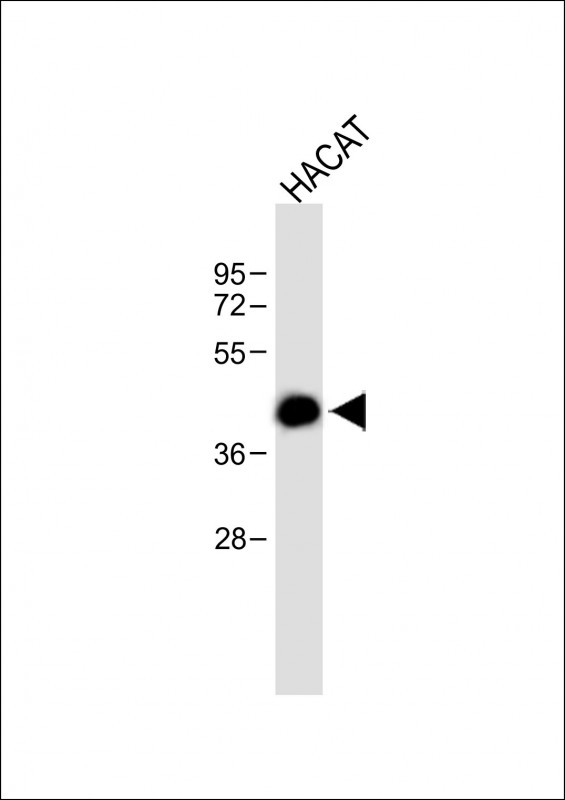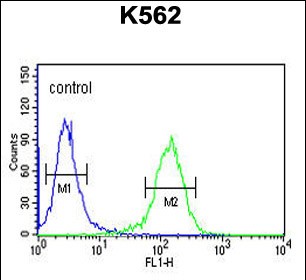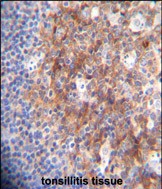MARCO Antibody (N-term)
Affinity Purified Rabbit Polyclonal Antibody (Pab)
- 产品详情
- 文献引用 : 2
- 实验流程
- 背景知识
Application
| WB, FC, IHC-P, E |
|---|---|
| Primary Accession | Q9UEW3 |
| Reactivity | Human |
| Host | Rabbit |
| Clonality | Polyclonal |
| Isotype | Rabbit IgG |
| Calculated MW | 52658 Da |
| Antigen Region | 13-40 aa |
| Gene ID | 8685 |
|---|---|
| Other Names | Macrophage receptor MARCO, Macrophage receptor with collagenous structure, Scavenger receptor class A member 2, MARCO, SCARA2 |
| Target/Specificity | This MARCO antibody is generated from rabbits immunized with a KLH conjugated synthetic peptide between 13-40 amino acids of human MARCO. |
| Dilution | WB~~1:500 FC~~1:10~50 IHC-P~~1:100~500 E~~Use at an assay dependent concentration. |
| Format | Purified polyclonal antibody supplied in PBS with 0.09% (W/V) sodium azide. This antibody is purified through a protein A column, followed by peptide affinity purification. |
| Storage | Maintain refrigerated at 2-8°C for up to 2 weeks. For long term storage store at -20°C in small aliquots to prevent freeze-thaw cycles. |
| Precautions | MARCO Antibody (N-term) is for research use only and not for use in diagnostic or therapeutic procedures. |
| Name | MARCO |
|---|---|
| Synonyms | SCARA2 |
| Function | Pattern recognition receptor (PRR) which binds Gram-positive and Gram-negative bacteria (PubMed:9468508). Also plays a role in binding of unopsonized particles by alveolar macrophages (By similarity). Binds to the secretoglobin SCGB3A2 (PubMed:12847263). |
| Cellular Location | Cell membrane; Single-pass type II membrane protein |
| Tissue Location | Expressed in alveolar macrophages (at protein level). Detected in macrophages from various tissues including thymus, kidney, Kupffer cells of liver, and spleen (PubMed:9468508) |
For Research Use Only. Not For Use In Diagnostic Procedures.

Provided below are standard protocols that you may find useful for product applications.
BACKGROUND
MARCO is a member of the class A scavenger receptor family and is part of the innate antimicrobial immune system. The protein may bind both Gram-negative and Gram-positive bacteria via an extracellular, C-terminal, scavenger receptor cysteine-rich (SRCR) domain. In addition to short cytoplasmic and transmembrane domains, there is an extracellular spacer domain and a long, extracellular collagenous domain. The protein may form a trimeric molecule by the association of the collagenous domains of three identical polypeptide chains.
REFERENCES
Wright, A.K., et al. J. Leukoc. Biol. 86(3):479-489(2009)
Trynka, G., et al. Gut 58(8):1078-1083(2009)
Arredouani, M.S., et al. J. Immunol. 175(9):6058-6064(2005)
Liu, T., et al. J. Proteome Res. 4(6):2070-2080(2005)
Seta, N., et al. Arthritis Rheum. 44(4):931-939(2001)
终于等到您。ABCEPTA(百远生物)抗体产品。
点击下方“我要评价 ”按钮提交您的反馈信息,您的反馈和评价是我们最宝贵的财富之一,
我们将在1-3个工作日内处理您的反馈信息。
如有疑问,联系:0512-88856768 tech-china@abcepta.com.






















 癌症的基本特征包括细胞增殖、血管生成、迁移、凋亡逃避机制和细胞永生等。找到癌症发生过程中这些通路的关键标记物和对应的抗体用于检测至关重要。
癌症的基本特征包括细胞增殖、血管生成、迁移、凋亡逃避机制和细胞永生等。找到癌症发生过程中这些通路的关键标记物和对应的抗体用于检测至关重要。 为您推荐一个泛素化位点预测神器——泛素化分析工具,可以为您的蛋白的泛素化位点作出预测和评分。
为您推荐一个泛素化位点预测神器——泛素化分析工具,可以为您的蛋白的泛素化位点作出预测和评分。 细胞自噬受体图形绘图工具为你的蛋白的细胞受体结合位点作出预测和评分,识别结合到自噬通路中的蛋白是非常重要的,便于让我们理解自噬在正常生理、病理过程中的作用,如发育、细胞分化、神经退化性疾病、压力条件下、感染和癌症。
细胞自噬受体图形绘图工具为你的蛋白的细胞受体结合位点作出预测和评分,识别结合到自噬通路中的蛋白是非常重要的,便于让我们理解自噬在正常生理、病理过程中的作用,如发育、细胞分化、神经退化性疾病、压力条件下、感染和癌症。








